With a Lending Club IPO on the horizon, and peer to peer lending receiving accolades in major press outlets for its innovative approach to helping both borrowers and investors, I want to pause a moment to focus on the retail investors of this asset class. We can herald the 8% returns peer to peer lending offers, but if this return is simply going to a tiny sliver of the country’s investors, how is that a significant national milestone?
On the contrary, this asset class is unique for the opportunity it offers to the nation as a whole. In this spirit, let me begin today by asking a question: for people who invest with an average of $12,000 (retail investors), what is the state of peer to peer lending?
Retail Investors on Prosper Marketplace
During my interview with Prosper’s CEO last month, Aaron Vermut spoke about how his company needed to grow its institutional investor base (banks, hedge funds, etc) in order to get the company off the ground. While Prosper had tried for years to grow through small-dollar investors, the company realized that hitting profitability required investors with much deeper pockets.
Vermut was pleased to share that these new institutional partners had fostered Prosper’s growth to the point where they were finally making money on each loan. With profitability out of the way, Prosper could now focus on growing its retail investor base.
This is a welcome change from the past season. Last quarter, it was not uncommon to see just a few A & B-grade loans available on the platform. See this tweet from February:

In the interview, Vermut spoke of his eventual goal to have retail investors comprise over 50% of the platform. While big-dollar investors were helpful at getting the company rolling, everyday Americans are much better at sticking with the company when times get tough.
“Hedge funds, if the climate changes, may be gone. A lot of these other guys have leverage, and the leverage providers are all the same people, and that creates correlation. If one bank says it is done, then everybody using that bank is done as well. That is why retail investors are so important.” (read: Vermut Reflects on Prosper’s $1B issued loans)
To help get started, Vermut stated how Prosper will be increasing availability of loans on the retail side of their platform. And recently they have been doing exactly that. In contrast to February’s sparse numbers, there were hundreds of loans available on their platform today:
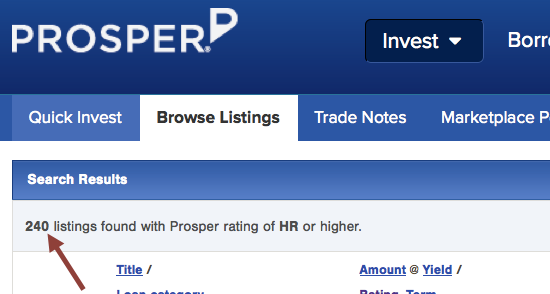
Retail Investors on Lending Club
Prosper has a good example to imitate. Lending Club has had a healthy retail investor community for years that supports an incredibly large volume of available loans. For example, there are currently over 1300 loans available on Lending Club’s site today:
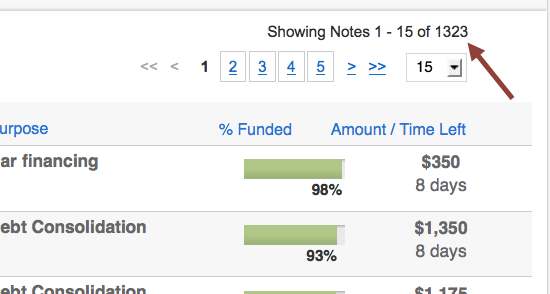
How large is Lending Club’s retail investor community? Around 40,000?
I have been wondering about the size of Lending Club’s retail community for years. Around 1pm yesterday, Lending Club sent the following email to their retail investor community:
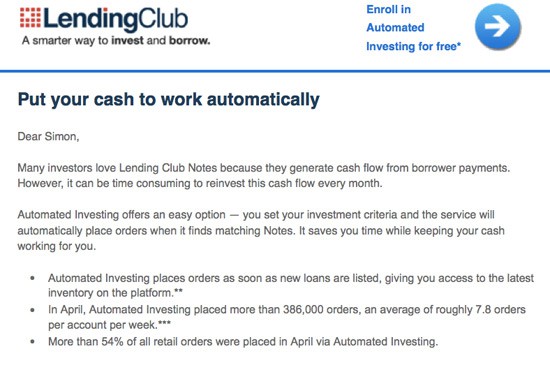
Basically, Lending Club sent out this email to show how popular its automated investing option is. In it, they gave some statistics about the program’s success:
- In April, Automated Investing (previously ‘PRIME’) placed more than 386,000 orders, an average of roughly 7.8 orders per account per week.
- More than 54% of all retail orders were placed in April via Automated Investing.
Aside from demonstrating the popularity of their new automated option, this email also gives us a clue to the size of their entire retail community. If 386,000 orders were placed via Automated Investing last month at 31.2/month per account (7.8 * 4 weeks), then there are 12,371 accounts using Automated Investing. If Automated Investing orders comprised 54% of orders, this also means Lending Club’s retail community placed around 714,815 total orders in April. Finally, if every account placed 31.2 orders last month, both automated and manual accounts, this means there are at least 22,910 active retail investors on Lending Club.
I actually think this estimate is too low. First of all, this calculation assumes non-automated investors had the same number of orders per month as automated ones. But those who invest manually would have a much smaller number of investment orders per month, perhaps ten or less. So while we can be more sure that 54% (12,000 investors) are using the automated option, the remaining 46% of the orders would be triple this estimate. So I actually peg the total number of active accounts in April to be above 40,000.
Whatever the case, it is these tens of thousands of investors that allow Lending Club to put out fantastic charts like this (found here):
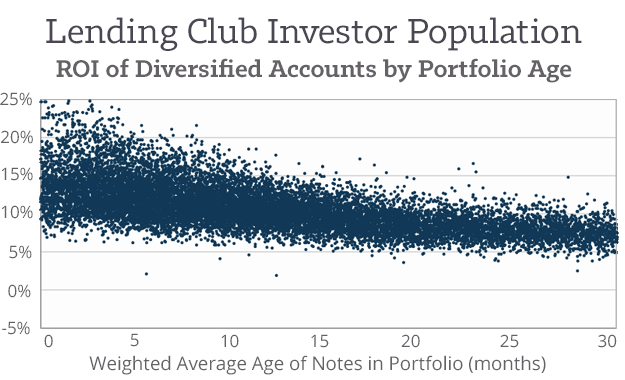
5 Factors to Catalyze a Thriving Retail Investing Community
As someone who desires this entire asset class to grow in health and popularity nationwide, I have great hopes that Prosper will soon be able to have an equally large population of average Americans participating on its platform as well. In this spirit, I would like to offer five platform factors to help make this happen. Obviously, the most important is a low default rate and a consistent return, but here are five additional drivers of growth:
#1. Loan Availability
It is really refreshing to see Prosper having hundreds of available loans on the platform these days. Back in February, when I was completing LendingMemo’s first video series, I had to skip over their screencast for this reason. However, these days the retail environment on Prosper is much more approachable, brought on by hundreds of newly available loans.
The two big reasons for availability are (1) diversification and (2) choice. First, investors need hundreds of loans on the platform if they want to easily create a diversified account in two hundred loans. Second, they want a few different risk-grades to choose from. Few investors want to be pigeon-holed into A-grade loans.
#2. Web Design
I am a believer that a website’s overall aesthetic and design is crucial for repeat customers and the brand-momentum this brings. In this way, I think both Lending Club and Prosper have some work to do. Prosper actually had a much-welcomed redesign last year (Lend Academy), and Lending Club recently completely redid theirs as well. However, both the sites could be further streamlined and simplified to look more like Upstart (below).

If peer to peer lending is to become a staple of investing for the average American, it will require a website that makes the experience simple, easy, and pleasureful. I actually think Prosper and Lending Club have a huge opportunity here. Financial websites are notorious for verbose, blocky design that makes investing a burden (example | example | example). As these nimble loan platforms innovate each year, how great would it be for one of them to become the first financial website nationwide with an award-winning design?
#3. Auto-Investing Tools
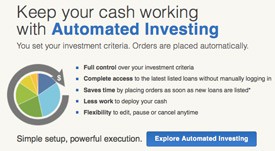 I never thought I would say this, but Prosper has finally been (slightly) outmatched by Lending Club in the area of automated investing. True, Prosper’s filtering continues to be much finer than Lending Club’s, which is lauded by precise filterers like myself (the minority). However, Lending Club’s new shiny Automated Investing has emerged as an option that seems both easier to understand and set up. Heck, they made it a link on their site’s main navigation.
I never thought I would say this, but Prosper has finally been (slightly) outmatched by Lending Club in the area of automated investing. True, Prosper’s filtering continues to be much finer than Lending Club’s, which is lauded by precise filterers like myself (the minority). However, Lending Club’s new shiny Automated Investing has emerged as an option that seems both easier to understand and set up. Heck, they made it a link on their site’s main navigation.
For peer to peer lending to be a popular and widespread practice, easy-to-understand automated tools need to exist that allow the average busy investor the freedom to only log in a few times per month or less.
#4. API Regulations
As I covered in my post last month on screen-scraping, Lending Club has shown itself to be somewhat hesitant to open up its API functionality (used by those with investing servers). Prosper, on the other hand, has generally kept its API wide open. Both these approaches have their drawbacks and advantages, with Prosper’s open API resulting in investor dollars being better/quicker put to work. However, Lending Club’s half-completed API means that small-dollar investors have often had more available loans to choose from.
Prosper actually did a great job adding some restrictions to this API (Lend Academy). Originally, investors could not pick up more than 50% of a loan. So if a $10,000 loan was added to the platform, the max any investor could pick up was a $5,000 note. However, this resulted in a small population of large-dollar investors vacuuming up the lion’s share of the available loans. As a result, Prosper changed the max to just 10%. The result of this change was, of course, a sudden jump in available loans on their platform, a better overall environment for retail investors.
I am really interested to see how the Lending Club and Prosper APIs mature in the coming years. I imagine they will continue to refine a server interface that balances the needs of both large and small-dollar investors.
#5. Time
 One of the biggest things a retail investor community needs to get going is time and patience. While large-dollar institutions can efficiently be flown in and marketed to, it may be a longer process to build a consistent thriving population of retail investors at a site like Prosper.
One of the biggest things a retail investor community needs to get going is time and patience. While large-dollar institutions can efficiently be flown in and marketed to, it may be a longer process to build a consistent thriving population of retail investors at a site like Prosper.
Having spoken at length with the management of this company, I believe Aaron when he says he wants retail investors to comprise the majority of his investor base in the coming years. In this way, I have taken a very patient approach toward the growth of Prosper’s retail community. Institutions have moneymen they pay to look at the thick data before jumping in, but the average small-dollar retail investor begins through recommendations from trusted friends and family.
Investor trust may take a bit of time to form, but as Prosper’s CEO said in his recent interview, this is how hundred-year companies are built.
[image credit: Bruno Corliodi “Grown-up”
Cliff “Pasture juniper (Juniperus communis ssp. depressa)“CC-BY 2.0]

Great article Simon. I agree that this industry needs a thriving retail investor community and I truly believe that both Lending Club and Prosper want that as well. I think we will see more improvements for retail investors in coming months as both companies look to improve their reputation with this community. There is big money waiting on the sidelines of this industry, but to really make a difference Lending Club and Prosper need to reach the retail investor. Thanks for highlighting this.
So true, Peter. I’m really looking forward to what’s coming.
Great analysis of the state of the p2p lending. I’m excited about the progress that both Prosper and Lending Club have made over the last year. There is still a huge marketing gap that needs to be filled up as word of mouth is just too slow. I don’t know how many times I’ve mentioned P2P lending to people and they give me a “are you crazy” stare, like I’m out funding loans off of craigslist posts. Educating individual investors is one of my goals as I talk with people.
Sounds like you and I often get the same response when sharing this asset class with others.
Definitely. Once I fully explain it, I’d say about 30% of the people realize the opportunity and the lightbulb goes on. For some reason, I think people attribute this to the idea that this is a Payday loan type business…which it is definitely not.
Your first point about loan availability is what drove my decision to put my money at Lending Club instead of Prosper when I was ready to open an account this March. I had set up an account at Prosper and poked around without transferring any money. I had decided to use Prosper due to the better automated investing option at the time… but when I saw the dearth of loans available to invest in, I went to Lending Club. I had no problem finding loans there, and now that they have dropped the account limit to $2500 for automated investing, it turns out to be the better platform for now. I hope Prosper does continue to make improvements, and maybe I’ll end up funding my account there at some point too.
Well put Jeff.
Within this conversation, it deserves mentioning that Prosper has actually been a better place to hang your hat if you’re an institution, particularly for the past year. I know a few fund managers who approached Lending Club but were turned down. However, Prosper was willing to have that conversation with them.
Prosper had a problem funding their loan growth. With only one institutional investor (who had just prior to new management stopped investments), they were hurting for investor dollars and they were beholden to a single institutional investor. Their growth was way behind LC. Now that they have picked up their growth and you see some very large names backing them, I’m willing to bet that they aren’t having those conversations with institutions anymore.
Perhaps not anymore, but I do think, for the past few seasons, that they were a better place than Lending Club for these groups to approach.
Completely agree. I started out at Prosper, but am now liquidating my Prosper acct to put everything into LC.
300+ loans available on Prosper the Tuesday (5/27/14) after Memorial Day.
I almost want to complain that it’s too many to look at!